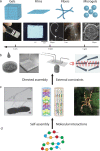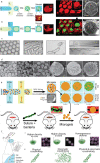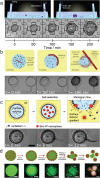From Protein Building Blocks to Functional Materials
- PMID: 33760579
- PMCID: PMC8155333
- DOI: 10.1021/acsnano.0c08510
From Protein Building Blocks to Functional Materials
Abstract
Proteins are the fundamental building blocks for high-performance materials in nature. Such materials fulfill structural roles, as in the case of silk and collagen, and can generate active structures including the cytoskeleton. Attention is increasingly turning to this versatile class of molecules for the synthesis of next-generation green functional materials for a range of applications. Protein nanofibrils are a fundamental supramolecular unit from which many macroscopic protein materials are formed. In this Review, we focus on the multiscale assembly of such protein nanofibrils formed from naturally occurring proteins into new supramolecular architectures and discuss how they can form the basis of material systems ranging from bulk gels, films, fibers, micro/nanogels, condensates, and active materials. We review current and emerging approaches to process and assemble these building blocks in a manner which is different to their natural evolutionarily selected role but allows the generation of tailored functionality, with a focus on microfluidic approaches. We finally discuss opportunities and challenges for this class of materials, including applications that can be involved in this material system which consists of fully natural, biocompatible, and biodegradable feedstocks yet has the potential to generate materials with performance and versatility rivalling that of the best synthetic polymers.
Keywords: biomaterial; condensate; drug delivery; fiber; film; gel; microfluidic; protein; self-assembly.
Conflict of interest statement
The authors declare no competing financial interest.
Figures








References
-
- Teng Z.; Xu R.; Wang Q. RSC Advances Beta-Lactoglobulin-Based Encapsulating Systems as Emerging Bioavailability Enhancers for Nutraceuticals : A Review. RSC Adv. 2015, 5 (2013), 35138–35154. 10.1039/C5RA01814E. - DOI
-
- Shen Y.; Nyström G.; Mezzenga R. Amyloid Fibrils Form Hybrid Colloidal Gels and Aerogels with Dispersed CaCO 3 Nanoparticles. Adv. Funct. Mater. 2017, 27 (45), 1700897.10.1002/adfm.201700897. - DOI
-
- Shen Y.; Posavec L.; Bolisetty S.; Hilty F. M.; Nyström G.; Kohlbrecher J.; Hilbe M.; Rossi A.; Baumgartner J.; Zimmermann M. B.; Mezzenga R. Amyloid Fibril Systems Reduce, Stabilize and Deliver Bioavailable Nanosized Iron. Nat. Nanotechnol. 2017, 12 (7), 642–647. 10.1038/nnano.2017.58. - DOI - PubMed
Publication types
MeSH terms
Substances
Grants and funding
LinkOut - more resources
Full Text Sources
Other Literature Sources

